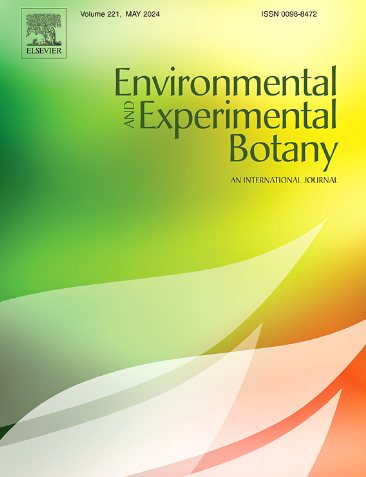代谢谱分析揭示了CO2富集条件下两个生长季节小扁豆(Lens culinaris Medik.)碳氮代谢的显著变化
IF 4.7
2区 生物学
Q2 ENVIRONMENTAL SCIENCES
引用次数: 0
摘要
升高的大气[CO2] (e[CO2])可能减轻水分胁迫对植物的影响。然而,尚不清楚这是否完全是由于气孔导度和节水的变化,还是也反映了e[CO2]下额外碳水化合物供应引发的代谢途径的变化。为了帮助解决这一知识差距,在一个水资源有限的农业生态系统中,在一个自由空气二氧化碳富集设施中,在两个截然不同的生长季节,一个高(远高于平均水平)降雨,一个低(远低于平均水平)降雨的过程中,分析了小扁豆叶片和根节的代谢物模式。开花时取样的组织代谢组学分析显示,不同季节对e[CO2]的反应不同。在高降雨季节,e[CO2]与叶片和根瘤中活性能量和氨基酸代谢的显著特征相关,特别是叶片和根瘤中蛋白质原氨基酸丰度的增加,这表明强烈刺激了根瘤的n2固定和叶片的N供应。在少雨季节,e[CO2]与高丰度的胁迫响应代谢物相关,包括糖和多元醇等假定的渗透保护剂以及一些含n化合物(脯氨酸、γ-氨基丁酸、腐胺),而叶片中蛋白质生成氨基酸的浓度降低。在结核中,e[CO2]与较低浓度的糖、多元醇和大多数蛋白质原氨基酸以及较高浓度的含氮应激代谢物有关。然而,在少雨季节,很少有证据表明e[CO2]促进了能量和氨基酸代谢。这项研究表明,e[CO2]放大而不是减轻了不同季节对扁豆代谢的影响。在高降雨季节,e[CO2]加强了与活跃生长和固氮相关的代谢模式,而在低降雨季节,e[CO2]加强了胁迫响应特征。本文章由计算机程序翻译,如有差异,请以英文原文为准。
Metabolite profiling reveals distinct changes in C-and N-metabolism of lentil (Lens culinaris Medik.) under CO2 enrichment in two contrasting growing seasons in the field
Elevated atmospheric [CO2] (e[CO2]) may alleviate the effects of water stress on plants. It is unclear however whether this results exclusively from changes in stomatal conductance and water savings or also reflects changes in metabolic pathways triggered by the extra carbohydrate supplies under e[CO2]. To help address this knowledge gap, metabolite patterns were analysed in leaves and nodules of lentils grown in a Free-Air CO2 Enrichment facility in a water limited agro-ecosystem over the course of two contrasting growing seasons, one with high (well above average), and one with low (well below average) rainfall. Metabolomic analyses of tissues sampled at flowering showed contrasting responses to e[CO2] in the contrasting seasons. In the high rainfall season, e[CO2] was associated with more pronounced signatures of active energy and amino acid metabolism in leaves as well as in nodules, and particularly increased abundance of proteinogenic amino acids in leaves and nodules, which suggested strong stimulation of nodule N2-fixation and N supply to leaves. In the low rainfall season, e[CO2] was associated with high abundance of stress responsive metabolites, including putative osmo-protectants such as sugars and polyols as well as some N-containing compounds (proline, γ-aminobutyric acid, putrescine), while the concentration of proteinogenic amino acids in leaves was reduced. In nodules, e[CO2] was linked to lower concentrations of sugars, polyols and most proteinogenic amino acids, along with higher concentrations of N-containing stress metabolites. However, there was little evidence that e[CO2] enhanced energy and amino acid metabolism in the low rainfall season. This study suggests that e[CO2] amplifies rather than mitigates the effect of different seasons on lentil metabolism. Whilst in a high rainfall season e[CO2] intensified metabolic patterns related to active growth and N-fixation, in a low rainfall season e[CO2] strengthened stress response signatures.
求助全文
通过发布文献求助,成功后即可免费获取论文全文。
去求助
来源期刊

Environmental and Experimental Botany
环境科学-环境科学
CiteScore
9.30
自引率
5.30%
发文量
342
审稿时长
26 days
期刊介绍:
Environmental and Experimental Botany (EEB) publishes research papers on the physical, chemical, biological, molecular mechanisms and processes involved in the responses of plants to their environment.
In addition to research papers, the journal includes review articles. Submission is in agreement with the Editors-in-Chief.
The Journal also publishes special issues which are built by invited guest editors and are related to the main themes of EEB.
The areas covered by the Journal include:
(1) Responses of plants to heavy metals and pollutants
(2) Plant/water interactions (salinity, drought, flooding)
(3) Responses of plants to radiations ranging from UV-B to infrared
(4) Plant/atmosphere relations (ozone, CO2 , temperature)
(5) Global change impacts on plant ecophysiology
(6) Biotic interactions involving environmental factors.
 求助内容:
求助内容: 应助结果提醒方式:
应助结果提醒方式:


